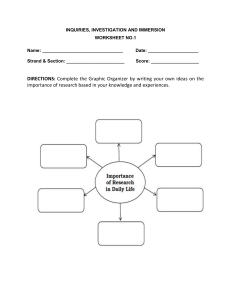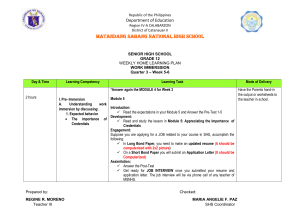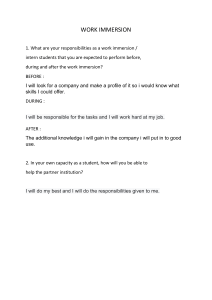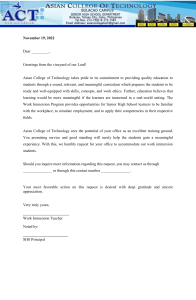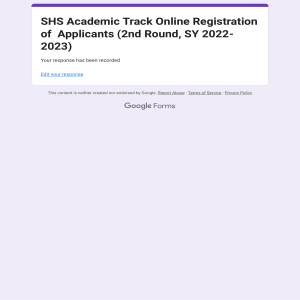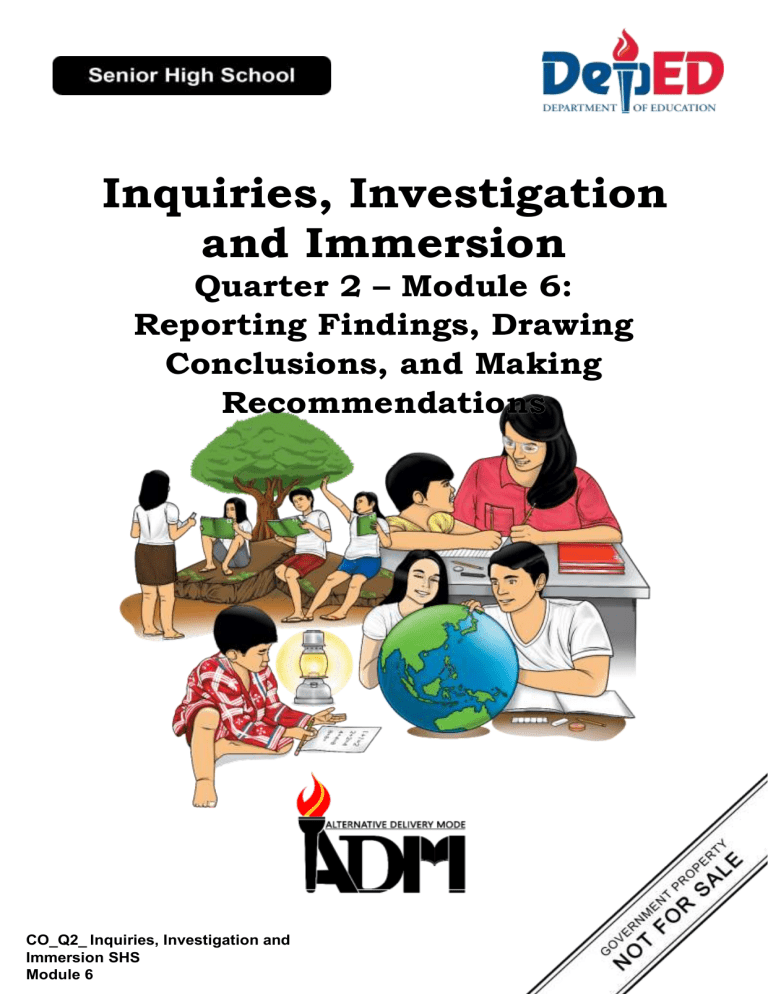
Inquiries, Investigation and Immersion Quarter 2 – Module 6: Reporting Findings, Drawing Conclusions, and Making Recommendatio CO_Q2_ Inquiries, Investigation and Immersion SHS Module 6 Inquiries, Investigation and Immersion Alternative Delivery Mode Quarter 2 – Module 6: Reporting Findings, Drawing Conclusions, and Making Recommendations Second Edition, 2021 Republic Act 8293, section 176 states that: No copyright shall subsist in any work of the Government of the Philippines. However, prior approval of the government agency or office wherein the work is created shall be necessary for exploitation of such work for profit. Such agency or office may, among other things, impose as a condition the payment of royalties. Borrowed materials (i.e., songs, stories, poems, pictures, photos, brand names, trademarks, etc.) included in this module are owned by their respective copyright holders. Every effort has been exerted to locate and seek permission to use these materials from their respective copyright owners. The publisher and authors do not represent nor claim ownership over them. Published by the Department of Education Secretary: Leonor Magtolis Briones Undersecretary: Diosdado M. San Antonio Development Team of the Module Writers: Evaluators: Illustrator: Layout: Management Team: Marjorie B. Yosores Emily A. Tabamo Rudilyn F. Zambrano Cheryll M. Sabaldana Jungie G. Palma Cathrine B. Pielago Christy C. Gabule-Dablo, DScN Maria Conception Sione E. Alpore Maria Cecilia N. Gabas Annarose J. Catian Jungie Palma Princess C. Tingcang Dr. Arturo B. Bayocot, CESO III, Regional Director Dr. Victor G. De Gracia Jr., CESO V, Asst. Regional Director Mala Apra B. Magnaong, CES, CLMD Bienvenido U. Tagolimot, Jr., PhD., Regional ADM Coordinator Marie Emerald A. Cabigas, PhD, EPS, LRMS Elson C. Jamero, EPS-Designate-TLE Erlinda G. Dael, PhD., CESE, CID Chief Celieto B. Magsayo, Div. LR Supervisor Andrian S. Tecson, Div. ADM Coordinator Printed in the Philippines by Department of Education – Regional Office 10 Office Address: Zone 1, Upper Balulang, Cagayan de Oro City 9000 Telefax: (088) 880-7071, (088) 880-7072 E-mail Address: region10@deped.gov.ph Inquiries, Investigation and Immersion Quarter 2 – Module 6: Reporting Findings, Drawing Conclusions, and Making Recommendations Introductory Message The purpose of this module is to guide the teacher as to what to do in dealing the students. This is an interactive way to test and evaluate the students’ learning process. The writer simplifies the instruction of every activity to be understood well. The importance of the module is to explore the literacy of the students. Motivating the students to use module is a great help to adapt the education for all programs. To our dearest students let yourself be free in exploring the module made for your literacy and learning process. This module is designed to test your skills in understanding and comprehending the different activities. This module involves logical flow of ideas to spread essential context regarding the learning process. The purpose refines completely new approach in selecting topic which inclined the interests of the learners. Additional insights might investigate the implications in identifying new problems and re-conceptualize. 1. What I Need to Do – the part used to introduce the learning objectives in this module. 2. What I Know – this is an assessment as to your level of knowledge to the subject matter at hand, meant specifically to gauge previous knowledge. 3. What’s In – the part used to connect your previous learning with the new lesson. 4. What’s New – the part used to introduce new lesson through a story, an activity, a poem, song, situation or activity. 5. What is It – the part that will help you discover and understand the lesson. 6. What’s More – the part that will help enrich your learnings of the lesson. 7. What I Have Learned – the part that will help you process what you have learned in the lesson. 8. What I Can Do – the part that allows you to apply what you have learned into real life situations. 9. Assessment – the part that evaluates your level of mastery in achieving the learning objectives. 10. Additional Activities – the part that enhances your learning and improves your mastery of the lesson. What I Need to Know Conclusion and Recommendations comprise Chapter 5 of your paper and is considered as the last step in accomplishing a research study. In this module, you are going to focus on learning the last two sections of your research paper as introduced above. The conclusion focuses on implying the totality of the result of the study, whether all the objectives of the study are satisfied or not. The conclusion also gives a comprehensive summary of the findings of the study. The recommendations section, on the other hand, allows the researcher to give his/her suggestions for the betterment and improvement of the study. This module is also designed to help young researchers to know the ways on how to improve the writing and presentation of research papers. As proofreading is important in submitting research papers, one must take note to consider all the significant points in pursuing the mentioned. At the end of this module, you are expected to learn the following: a. define and understand the concepts of research conclusions, recommendations, and written reports; b. create their own conclusion, recommendations, and reports based on their specific research topics; and appreciate the importance and usage of research conclusion, recommendations, and written reports in a research study. How to learn from this module? To achieve the objectives of this module, do the following: 1. 2. 3. 4. Read the overview to assess the coverage of this module. Take the pre-test to check your comprehension of the topics. Carefully read all the discussions of this module. Accomplish the activities provided per lesson. Always take note of the given directions. 5. Take the post-test to check your learning. 6. Have an enjoyable learning experience! 1 CO_Q2_ Inquiries, Investigation and Immersion SHS Module 6 What I Know Read and answer the questions below. Write the letter of your answer on your notebooks or answer sheets provided. _____ 1. This is a section in the research paper that focuses on providing a comprehensive summary of the findings and points out what was learned from the study. a. Summary c. Recommendations b. Conclusion d. References _____ 2. What section in a research paper gives the researcher the chance to give suggestions to matters for the improvement of the research study? a. Summary c. Recommendations b. Conclusion d. References _____ 3. Which of the following is not the purpose of the research conclusion? a. It stresses out the importance of the thesis statement b. It gives the written work a sense of completeness c. It does not leave a final impression on the readers d. It demonstrates good organization. _____ 4. Which of the following characteristics of recommendations states that it should not be ambiguous and must be specific? a. Recommendations must be brief b. Recommendations should be clear c. Recommendations must be precise d. None of the above _____ 5. This is defined as written documents that discuss a certain issue or topic. a. Research study c. Research report b. Research source d. Research draft _____ 6. It is a content of the research report that focuses on explaining the reason of the conduct of the study. a. Introduction c. Methodology b. Review of Related Literature d. Results and Discussion _____ 7. A part of the research report that holds the findings of the study and the discussion of each finding. a. Introduction c. Methodology b. Review of Related Literature d. Results and Discussion _____ 8. Which among the parts of your research report focuses on presenting relevant information regarding the research topic? a. Introduction c. Conclusion b. Review of Related Literature d. Recommendations 2 CO_Q2_ Inquiries, Investigation and Immersion SHS Module 6 _____ 9. From the given choices below, which consideration in making research reports focuses on securing the correct in-text citation? a. Researcher must decide on what are the sections that must be included in your report. b. Researcher must write your report clearly and concisely. c. References should be carefully and accurately cited. d. Report should be edited by several times _____ 10. Which of the following considerations in making research reports discusses the importance of proofreading? a. Researcher must decide on what are the sections that must be included in your report. b. Researcher must write your report clearly and concisely. c. References should be carefully and accurately cited. d. Report should be edited by several times. 3 CO_Q2_ Inquiries, Investigation and Immersion SHS Module 6 Lesson 1 Forming Logical Conclusions What’s In In the previous lesson that you have, you were able to study all about the different gathering and analysis procedures for your research data. The previous module discussed the importance of analyzing your data. Data analysis is an important part of your research since this will determine the mechanism of your research. In quantitative research, data analysis will help you prove a hypothesis, while in qualitative research, data analysis can give the researcher the overall theme of the respondent’s responses. Data analysis differs from the type of data collected as well as the type of research conducted, hence, qualitative and quantitative research follows different data analysis procedures. Accordingly, qualitative research follows data analysis procedures such as content analysis, discourse analysis, grounded theory, narrative analysis, and thematic analysis. Quantitative research data, on the other hand, is commonly analyzed with the appropriate statistical tools design for your study. The number of data as well as the goal of the study, will help determine the appropriate statistical tool to be used. After learning the different methods for analyzing your data, the researchers must now consider the overall conclusion for the study. In this part, you are now going to assess whether your research is successful or not based on the data gathered and analyzed. For this module, you are going to learn how to do an efficient and effective reporting of your research findings, research conclusion, and recommendations. 4 CO_Q2_ Inquiries, Investigation and Immersion SHS Module 6 What is It Conclusion are the first section of your Chapter 5. This section as described by Prieto et al. (2017), is commonly composed of the inclusive summary of findings of the research study. In this section, you can find facts that were learned from the inquiry. The conclusion serves an important part in making a research paper as it is the chance for the researcher to leave a lasting impression. Research conclusion has its important roles and purpose in a research study. These are commonly elaborated as the following: a) it stresses out the importance of the thesis statement, b) it gives the written work a sense of completeness, c) it leaves a final impression to the readers, and d) it demonstrates good organization. When concluding your paper, you must abide by the following characteristics (Prieto et al., 2017). These characteristics will guide you to produce a quality research conclusion. 1. Conclusions are inferences, deductions, abstractions, implications, interpretations, general statements, and/or generalizations based upon the finding. 2. Conclusions should appropriately answer the specific questions raised at the beginning of the investigation in the order that they are given under the statement of the problem. 3. Conclusions should point out what was factually learned from the inquiry 4. Conclusions should be formulated concisely, that is, brief and short, yet they convey all the necessary information resulting from the investigation. Below are the strategies that you could follow in making your conclusions: 1. You briefly discuss or reecho your Introduction. 2. Put a final impression on your readers by giving them a hint of the application of your research towards their daily life. 3. Get more good impressions by concluding the importance of the study towards society. 4. Leaving a question to the readers which could be an avenue for gaining a new perspective. 5 CO_Q2_ Inquiries, Investigation and Immersion SHS Module 6 What’s More Activity 1. Directions. Visit your library or surf the internet for five (5) free and available research papers. Analyze how did the authors crafted their conclusion, and supply your answer on the space allotted below. Research Title Author and Date Published Analysis of the Research Conclusion (Include website if source is from the internet) What I Can Do Activity 2 Directions. Craft your research conclusion based on the discussion given above. 6 CO_Q2_ Inquiries, Investigation and Immersion SHS Module 6 Lesson 2 Making Recommendations Based on Conclusions What’s In Congratulations! You have finished the first topic! You are on your way to completing this module! In the previous lesson, you have learned about the research conclusion, its function, parts and techniques in writing. Conclusion, as discussed, is one of the most important part of your research paper. The important roles and purpose of research conclusions are summarized into the following: a) it stresses out the importance of the thesis statement, b) it gives the written work a sense of completeness, c) it leaves a final impression to the readers and d) it demonstrates good organization. Writing a good conclusion will help you and your readers in assessing whether the research study was conducted successfully. At this moment, you are going to learn another topic! For this lesson, we are going to learn about Research Recommendations. This lesson will focus in teaching you about the research recommendation mechanism and how to write it. 7 CO_Q2_ Inquiries, Investigation and Immersion SHS Module 6 What is It After crafting your research conclusion, the next step for you to take is to write your research recommendations. Recommendations will be the last part of your Chapter 5. A recommendation is commonly known as the section where you can give suggestions on the matters relative to your research that must be improved. When writing you must take the following considerations: a) Recommendations must be brief. When writing your recommendations, take note to write them concisely and as brief as possible. b) Recommendations should be clear. You must state the specific suggestions that you want to imply in your study. c) Recommendations must be precise. When giving suggestions, you should avoid vague recommendations to secure sufficient results. As recommendations should be crafted briefly, clearly, and precisely, here are some guidelines by Prieto et al. (2017) that you can use. 1. You must avoid writing broad and generic recommendations. Also, avoid recommendations that are directly related to the topic of the research. 2. Remember that recommendations are one step further than the conclusion. 3. You must take into consideration that recommendations must be specified according to the areas of concern (i.e., academe, policymakers, etc.) 8 CO_Q2_ Inquiries, Investigation and Immersion SHS Module 6 What’s More Activity 3. Directions. For this activity, you will need the sources that you have used for the completion of the last activity. To do this activity, you need to read and analyze the contents of the recommendation of each identified source. Write all your answers on the table provided below. Research Title Author and Date Published Analysis of the Research Recommendation (Include website if source is from the internet) What I Can Do Activity 4 Directions. Craft your research recommendation based on the discussion given above 9 CO_Q2_ Inquiries, Investigation and Immersion SHS Module 6 Lesson Writing and Presenting Clear Reports 3 What is It After accomplishing all of the contents of your research paper, the next thing that you must do is to prepare and write a research report. Accordingly, research reports are defined as written documents that discuss a certain issue or topic. It is a document that holds all the information about a research study from its introduction down to the recommendations. In making your report, you must take the following considerations: 1. You must decide on what are the sections that must be included in your report. Take note to include the findings and discussion of your study. You should also include the introduction, methodology, conclusion, and recommendations of your study. 2. You must write your report clearly and concisely. Main idea should be highlighted and is supported by statements for elaboration and explanation. Commonly, research reports are written in the past tense form. Words used should be understandable by all of the possible readers, thus, jargon terms must be avoided. 3. References should be carefully and accurately cited. Citing your references is a must. Paraphrasing is also needed to avoid plagiarism. 4. Report should be edited by several times. Checking and proof- reading are a must to secure that all entries and information stated on the report hold credibility and transparency. When writing a research report, you must take note that it should be in a straightforward manner. A research report is composed of five (5) integral parts, namely: The Introduction, Review of Related Literature, Methodology, Results and Discussion and Summary, Conclusion, and Recommendations. The specifications of the parts are explained below: a) Introduction Your introduction must contain an explanation regarding the reason for the conduct of the study. It must also have the research framework, statement of 10 CO_Q2_ Inquiries, Investigation and Immersion SHS Module 6 the problem and objectives, the significance of the study, and scope and limitations. b) Review of Related Literature This chapter focuses on presenting relevant information regarding the topic. Citing the references appropriately is a must in this section. c) Methodology Information found in a research methodology is commonly the research design, research respondents, setting, the research method, and the analysis procedure. d) Results and Discussion This chapter holds the findings of the study and the discussion for each finding. The results of the study must be written clearly and objectively. There are a lot of ways that can be used in presenting results, some of which are by the use of tables, graphs, and figures. These data should then be discussed. e) Summary, Conclusion, and Recommendations Commonly, the summary of the research paper gives brief information about the research problems, methodology, and findings. The conclusion, on the other hand, gives provides direct answers to the research problems. Recommendations prioritize the suggestions that can lead to the improvement of the study. What I Have Learned Based on the lesson, I have realized that __________________________________________________________________________________ ________________________________________________________________ ________________________________________________________________ ________________________________________________________________ ________________________________________________________________ ________________________________________________________________ ________________________________________________________________ ________________________________________________________________ ________________________________________________________________ ________________________________________________________________ 11 CO_Q2_ Inquiries, Investigation and Immersion SHS Module 6 What I Can Do Accomplishing your research report does not signify the end of your research. After doing such, you must take into consideration the evaluation of its quality. Take note that the ultimate goal of evaluating your paper is to secure its quality. Corbin and Strauss (1990) suggest the following guidelines in assessing and evaluating research papers. 1. 2. 3. 4. How was the sample selected? What major themes or categories emerged? What were some evidential or incidental proofs pointing to thecategories? What were some of the statements of relationships made during the analysis and on what grounds were they formulated and validated? 5. Were there discrepancies and how were they accounted for? 6. How and why was the core theme, is applicable, selected? 7. Are the concepts systematically related? The concepts and their relationships must be developed systematically to generate a theoretical explanation of a phenomenon of interest. 8. Was the process taken into account? A clear discussion of the process enables theory users to explain theory consequences under changing circumstances. 9. Are the theoretical findings significant and to what extent? 10. Do the findings become part of the body of the research topic? The following sample format can help you in developing your research paper. The discussion for each component is described in the contents of this module. 12 CO_Q2_ Inquiries, Investigation and Immersion SHS Module 6 RESEARCH TITLE STUDENT’S NAME (FIRST NAME, MIDDLE NAME, LAST NAME) RESEARCH PAPER SUBMITTED TO THE FACULTY OF THE DEPARTMENT OF , SCHOOL-SENIOR HIGH SCHOOL, IN PARTIAL FULFILLMENT OF THE REQUIREMENTS OF THE SUBJECT INQUIRIES, INVESTIGATIONS, AND IMMERSION (MONTH AND YEAR OF COMPLETION) 13 CO_Q2_ Inquiries, Investigation and Immersion SHS Module 6 Title Table of Contents Abstract Chapter I. Introduction a. b. c. d. e. Background of the Study Statement of the Problem Objectives of the Study Significance of the Study Scope and Limitations of the Study Chapter 2. Review of Related Literature a. Overview/Introduction of the Review of Related Literature b. Body c. Conclusion Chapter 3. Methodology Chapter 4. Results and Discussion Chapter 5. Summary, Conclusions, and Recommendations References Appendices Directions: Craft your research paper following the guidelines set on the preceding topics. 14 CO_Q2_ Inquiries, Investigation and Immersion SHS Module 6 Assessment Read and answer the questions below. Write the letter of your answer on your notebooks or answer sheets provided. _____ 1. This is a section in the research paper that focuses on providing a comprehensive summary of the findings and points out what was learned from the study. c. Summary c. Recommendations d. Conclusion d. References _____ 2. What section in a research paper gives the researcher the chance to give suggestions to matters for the improvement of the research study? c. Summary c. Recommendations d. Conclusion d. References _____ 3. Which of the following is not the purpose of the research conclusion? e. It stresses out the importance of the thesis statement f. It gives the written work a sense of completeness g. It does not leave a final impression on the readers h. It demonstrates good organization. _____ 4. Which of the following characteristics of recommendations states that it should not be ambiguous and must be specific? e. Recommendations must be brief f. Recommendations should be clear g. Recommendations must be precise h. None of the above _____ 5. This is defined as written documents that discuss a certain issue or topic. c. Research study c. Research report d. Research source d. Research draft _____ 6. It is a content of the research report that focuses on explaining the reason of the conduct of the study. c. Introduction c. Methodology d. Review of Related Literature d. Results and Discussion _____ 7. A part of the research report that holds the findings of the study and the discussion of each finding. c. Introduction c. Methodology d. Review of Related Literature d. Results and Discussion _____ 8. Which among the parts of your research report focuses on presenting relevant information regarding the research topic? c. Introduction c. Conclusion d. Review of Related Literature d. Recommendations 15 CO_Q2_ Inquiries, Investigation and Immersion SHS Module 6 _____ 9. From the given choices below, which consideration in making research reports focuses on securing the correct in-text citation? e. Researcher must decide on what are the sections that must be included in your report. f. Researcher must write your report clearly and concisely. g. References should be carefully and accurately cited. h. Report should be edited by several times _____ 10. Which of the following considerations in making research reports discusses the importance of proofreading? e. Researcher must decide on what are the sections that must be included in your report. f. Researcher must write your report clearly and concisely. g. References should be carefully and accurately cited. a. Report should be edited by several times. 16 CO_Q2_ Inquiries, Investigation and Immersion SHS Module 6 References Prieto, N.G., Naval, V.C. & Carey, T.G. (2017). Practical research 1 for senior high school: Qualitative. Quezon City, Metro Manila: LORIMAR Publishing, Inc. Prieto, N.G., Naval, V.C. & Carey, T.G. (2017). Practical research 2 for senior high school: Quantitative. Quezon City, Metro Manila: LORIMAR Publishing, Inc. Torneo, A.R. & Clamor-Torneo, H.S. (2017). Practical research 2: An introduction to quantitative research. Quezon City: SIBS Publishing House, Inc. Answer Key 1. B 2. C 3. C 4. B 5. C 6. A 7. D 8. B 9. C 10.D What I Know and Assessment 17 CO_Q2_ Inquiries, Investigation and Immersion SHS Module 6 For inquiries or feedback, please write or call: Department of Education - Bureau of Learning Resources (DepEd-BLR) Ground Floor, Bonifacio Bldg., DepEd Complex Meralco Avenue, Pasig City, Philippines 1600 Telefax: (632) 8634-1072; 8634-1054; 8631-4985 Email Address: blr.lrqad@deped.gov.ph * blr.lrpd@deped.gov.ph 18 CO_Q2_ Inquiries, Investigation and Immersion SHS Module 6
